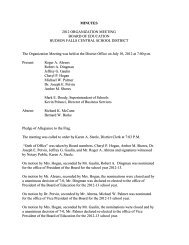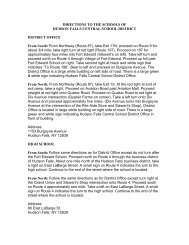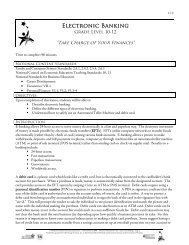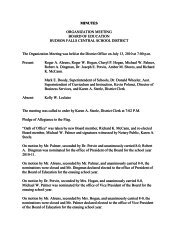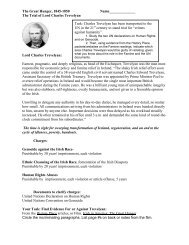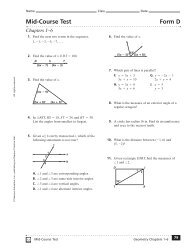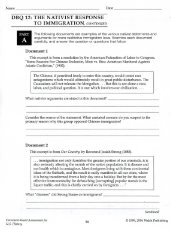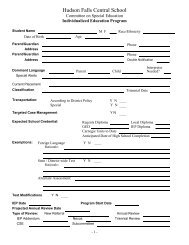Understanding Your Paycheck Information Sheet
Understanding Your Paycheck Information Sheet
Understanding Your Paycheck Information Sheet
You also want an ePaper? Increase the reach of your titles
YUMPU automatically turns print PDFs into web optimized ePapers that Google loves.
1.13.1.F1FAMILY ECONOMICS & FINANCIAL EDUCATION<strong>Understanding</strong> <strong>Your</strong><strong>Paycheck</strong>Methods For Paying Employeeseceiving a paycheck, especially if it is an individual’s first, can be the highlight of a person’s day. However, many are oftenR shocked when they learn almost 31% of their paycheck is missing. By learning about paychecks, paycheck deductions, andrequired employment forms, a person will be able to understand the amount received on their paycheck andensure they have been paid the correct amount from the employer for the time worked.There are three ways an employer may handle paying his/her employees:1. <strong>Paycheck</strong>— This is the most common method. The employer physically provides the employee withhis/her paycheck. The paycheck stub is attached to the paycheck to show the deductions. Theemployee is responsible for handling the paycheck.2. Direct Deposit— Employers directly deposit the employee’s paycheck into his/her authorized account. On payday, theemployee receives a paycheck stub detailing the paycheck deductions. This method is more secure because there is no directhandling of the check and the employee knows exactly which day his/her paycheck will be deposited and available for use.3. Payroll Card— The third and newest way is by using a payroll card. A payroll card is a prepaid card that is offered toemployees as an alternative to paper paychecks or directly depositing wages into an employee’s financial institution account.Most payroll cards are smart cards, which have money electronically loaded onto them each pay period with fundsautomatically deducted from the balance when a purchase is made. PayrollRegardless of which method employees choose to receive their cards function similarly to a debit card, except the funds are not linked to apayment, it is important for the employee to understand checking account. The funds are directly deposited by an employer into anpaycheck deductions taken out of a paycheck and what they are account at a financial institution that is linked to the payroll card. Once theused for.employee’s wages are credited to an account, the employee can use the cardfor ATM withdrawals or to make purchases.here may be numerous fees associated with payrollT cards. The number and amount of fees depends uponthe financial institution. For example, some payroll cardsoffer just one ATM withdrawal per pay period free ofcharge, while others offer three to five withdrawals free ofcharge. Employers can negotiate with financial institutionsto reduce the number of fees and someemployers will pay all or part of the payrollcard fees. Therefore, it is important foremployees to obtain a list of all fees beforesigning up to use a payroll card.Payroll Card FeesThe following are examples of fees charged by payrollcard companies:• monthly or annual fee;• ATM fee;• inactivity fee;• fee after a specific number of transactions have been used;• replacement fee if the card is lost, stolen, or destroyed;• load fee (when funds are placed on the card account);• point of sale (POS) fee for using the card at a point of saleterminal, or an electronic payment processor.Consumer Protection With Payroll CardsPayroll card users are protected through Regulation E, or the Electronic Fund Transfer Act. If a payroll card is stolen orfraudulent transactions are completed, the payroll card holder is liable for only $50 if the lost or stolen card is reported to thesponsoring financial institution within 48 hours. The FBI estimates that over four million paper paychecks are stolen annually(Visa USA, Inc.). Considering there is no legal protection for consumers whose paychecks have been stolen, Regulation Eprovides safety and protection for payroll card holders.Safety tips to follow when using a payroll card include memorizing the Personal Identification Number (PIN) and not giving itout to anyone. Also, if a payroll card is lost or stolen, it should be reported to the sponsoring financial institution immediately.© Family Economics & Financial Education – Revised September 2006 – <strong>Paycheck</strong>s and Taxes Unit –<strong>Understanding</strong> <strong>Your</strong> <strong>Paycheck</strong> and Tax Forms – Page 1Funded by a grant from Take Charge America, Inc. to the Norton School of Family and Consumer Sciences at the University of Arizona
<strong>Understanding</strong> <strong>Your</strong> <strong>Paycheck</strong>—Payroll Cards ContinuedPayroll Card BenefitsThere are many benefits for both employers and employees to use payroll cards.For employers• lower internal costs: the costs associated with producing, handling, and distributing paychecks iseliminated.For Employees• Increased safety: payroll cards reduce the need to carry large amounts of cash.• 24 hour access to funds and the ability to make online purchases easily.• No check cashing fees each pay period which costs unbanked Americans roughly $8 billion annually (Visa USA, Inc.).• Access to an electronic monthly statement of transactions—a great money management tool• Option of a second card: allowances for children, send money internationally to family without additional hassleFinancial institutions benefit from the payroll card arrangement because many unbanked consumers who begin to use a payroll cardbecome traditional financial institution account users. In addition, financial institutions profit from the fees charged to employees,employers, and merchants.1.13.1.F1Form I-9The Form I-9 is the Employment EligibilityVerification Form is used to verify the eligibility ofindividuals and to avoid hiring undocumented workers.All employees, citizens, and non-citizens mustcomplete a Form I-9 at the time of hire. Employeesmust provide documentation which establishes identityand employment eligibility. Examples include a driver’slicense, passport, Social Security card, and birthcertificate.Form W-2The Form W-2 is also known as a Wage and TaxStatement. It states the amount of money earned andtaxes paid throughout the previous year. The FormW-2 is used to file taxes. By January 31, employersshould mail a Form W-2 to each employee for theprevious year.Form W-4Regardless of the job, every new employee will be asked tocomplete a Form W-4 also known as an Employee’s WithholdingAllowance Certificate. The information provided on this formdetermines the percentage of gross income to be withheld for taxes.Federal taxes are the largest deduction on an individual’s income.On the Form W-4, the federal government allows taxpayers toclaim certain allowances. An allowance is used to determine theamount of federal taxes withheld from the paycheck. An employeemay claim a personal allowance if no one else claims them as adependent. A dependent is a person who relies on the taxpayerfor financial support.The Internal Revenue Service is the governmental agencyresponsible for collecting federal taxes, issuing regulations, andenforcing tax laws written by the United States Congress. Theamount of taxes withheld from an individual’s paycheck dependsupon his/her income and information provided on the Form W-4.Payroll cards have no check cashing fees, which costs unbanked Americans roughly $8 billion annually (Visa USA, Inc.).Taxesonetary deductions are subtracted for mandatory systematic taxes, employee sponsored medical benefits, and/orM retirement benefits. Taxes are compulsory charges imposed on citizens by local, state, and federal governments used tofund public goods and services. The United States tax system operates on an ongoing payment system. This means as a personearns income, taxes are paid immediately on the income. There are two types of taxes: progressive and regressive.Progressive taxes take a larger percentage of income from high income taxpayers. The more a person earns, the more he/shepays in taxes. Examples include Federal and State taxes.Regressive taxes are not based on one’s ability to pay. As income rises, the tax percentage remains the same or decreases.Higher income taxpayers are proportionally charged less. Examples include Medicare and Social Security.© Family Economics & Financial Education – Revised September 2006 – <strong>Paycheck</strong>s and Taxes Unit –<strong>Understanding</strong> <strong>Your</strong> <strong>Paycheck</strong> and Tax Forms – Page 2Funded by a grant from Take Charge America, Inc. to the Norton School of Family and Consumer Sciences at the University of Arizona
EmployeeBeakens, JoeEmployee Address293 Michael GroveBillings, MT 59102BReading a <strong>Paycheck</strong> StubSSN201-92-4856EXAMPLEAOn-The-GoCheck #1641.13.1.F1<strong>Understanding</strong> <strong>Your</strong> <strong>Paycheck</strong>CCheck Amount$1,102.98Pay Type- Deductions Current Year-to-dateGross Pay DJ$1,353.33 Federal WithholdingEState WithholdingFFed OASDI/EE or Social Security GRed MED/EE or MedicareMedical401 K$106.00$40.82$83.91$19.62$0.00$0.00$636.00$244.92$503.46$117.72$0.00$0.00ITotals $250.35 $1,502.10Pay Period 6/11/2006-7/11/2006A typical paycheck has two parts: the actual check and a paycheck stub. A paycheck stub lists the paycheck deductions as well as otherimportant information including:Personal <strong>Information</strong>—States the employee’s full name, address, and social security number.A. Pay Period—The length of time for which an employee’s wages are calculated usually weekly, bi-weekly, twice a month, or monthly.B. Gross Pay—The total amount of money earned during the pay period before deductions. If a person earns an hourly wage, gross payis calculated by multiplying the number of hours worked by the wage. For example, if a person works 45 hours in a pay period earning$6.25 per hour, his/her gross pay would be $281.25. If a person is on salary, earning a set amount for a specified time period, thegross pay is the salary amount divided by the specified time period. For example, if a person earns $24,000.00 per year, his/her grosspay would be $2,000.00 per month.C. Net Pay—The amount of money left after all deductions have been withheld from the gross pay earned in the pay period.D. Deductions—The amount of money subtracted or deducted from the gross pay for mandatory systematic taxes, employee sponsoredmedical benefits, and/or retirement benefits.E. Federal Withholding Tax— The amount required by law for employers to withhold from earned wages to pay taxes. Thisrepresents the largest deduction withheld from an employee’s gross income. The amount withheld depends upon two things: theamount of money earned and the information provided on the Form W-4.F. State Withholding Tax—The percentage deducted from an individual’s paycheck to assist in funding government agencies withinthe state. The percentage of deduction depends upon the amount of gross income the employee has earned.G. FICA (Federal Insurance Contribution Act)—This tax includes two separate taxes: Fed OASDI/EE or Social Security and FedMED/EE or Medicare. These two taxes can be combined as one line item or itemized separately on a paycheck stub.• Fed OASDI/EE or Social Security—The nation’s retirement program. This tax helps provide retirement income forelderly and pays disability benefits. Social Security taxes are based upon a percentage (6.2%) of the employee’s gross income.The employer matches the contribution made by the employee.• MED/EE or Medicare—The nation’s health care program for the elderly and disabled. This tax provides hospital andmedical insurance to those who qualify. Medicare taxes are based upon a percentage (1.45%) of the employee’s gross income.H. Medical—The amount taken from the employee’s paycheck for medical benefits. This occurs when the employer has a medical planfor employees, but does not pay full coverage for his/her benefits.I. Retirement Plan—The amount an employee contributes each pay period to a retirement plan. A specified percentage of thecontribution is often matched by the employer. This may be a 401K, state, or local retirement plan.J. Year-to-Date– Totals all of the deductions which have been withheld from an individual’s paycheck from January 1 to the last day ofthe pay period indicated on the paycheck stub.H© Family Economics & Financial Education – Revised September 2006 – <strong>Paycheck</strong>s and Taxes Unit –<strong>Understanding</strong> <strong>Your</strong> <strong>Paycheck</strong> and Tax Forms – Page 3Funded by a grant from Take Charge America, Inc. to the Norton School of Family and Consumer Sciences at the University of Arizona



